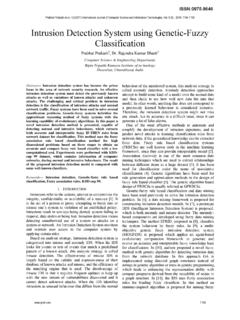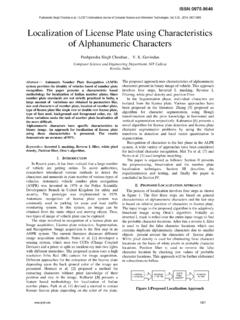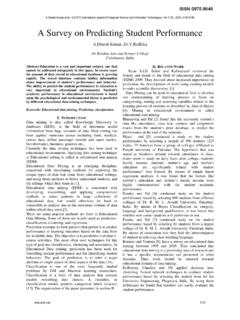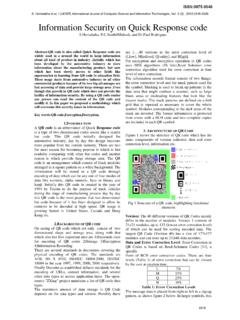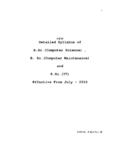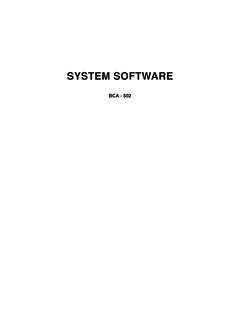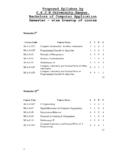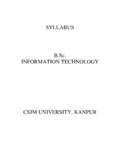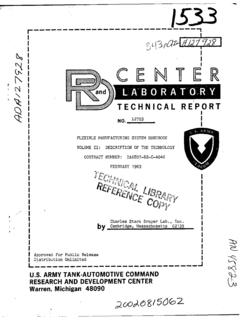Transcription of Communication Amoung Agents Using SACA …
1 Communication Amoung Agents Using SACA architecture Ashwini K1, Dr M V Vijayakumar2 1 Research Student, Jain University, Bangalore, India. 2 Research Guide, Dr Ambedkar Institute of Technology, Bangalore, India. Abstract This paper deals the different cognitive architectures where in the existing cognitive architectures the following disadvantages are observed no Communication between the Agents . Individual Agents will perform the task hence the performance will be slow when compared to Agents performing in a group. In EM-One architecture there is Communication between only two Agents .
2 In the proposed SACA architecture the main concentration is on the Communication and coordination among the group of Agents . The main advantage of the proposed is that it can be used in military applications. A highly motivated agent communicates with each other and hence increases performance. Keywords Cognitive Science, Cognitive architecture , agent , Communication , Coordination. I. INTRODUCTION The marriage between the Freudian and the Turing revolutions was a unhappy marriage which resulted to the birth of cognitive science.
3 Further, it was spiritual by the early development of mathematical theory of Communication and cybernetics. It was first preceded in natural science of information. By 1930s, Sigmund Freud the revolutionary idea that most of the operation of mind is hidden in the layer of sub consciousness. The problem was that treatment for mental problems (psychoanalysis) had grown so based on guessing and void of empirical content that it began to be regarded as unscientific. The scientific community was liberating from an erroneous notion to understand the working of mind and have sequence of conception undertaking the science with no business.
4 This was the birth of behaviorism, between 1930 to 1950 in the predominant school of psychology. Before the turn of 20th century, Camillo Golgi and Santiago Raman y cajol works led to punctilious description of the structure of neuron and additionally the hypothesis that the neuron is the fundamental functional unit of the brain. Nobel Prize in Medicine in 1906. Infelicitously, neither Freud's nor skinner's adherents was not pellucid with the conception of cognitive function in neuron.
5 Already in the tardy of artificial neural networks. John von Neumann one of the greatest scientific geniuses of 20th century he worked on the conceptual espousement between Turing work on formal theories of information that is the theory of neural science. In a set of lectures in 1955 shortly afore his death, became the book The Computer & the Brain, Von Neumann (1958), suggested that the neurons in the interpreted as performing computation. The model is as follows: the brain receives information by sensing which can be given as the input data to the system.
6 The brain takes the input data and process the data and engenders the results. The conception of this digital computation can be utilized as a framework for investigation that what transpires in between the input and output. This was missing in the behavioral theories which will focus only on replication and stimulus cognation. The brain according to this incipient model it has some concrete functionality like information processing which will affect stimulus to replication but it will be investigated in its own terms as computational process.
7 This amalgamation of the theory of computation, conceptions an incipient research program for investigating what transpires in the ebony box of the mind that is rigorous and scientifically venerable. Noam Chomsky withal worked with Neumann in 20th century. In Chomsky published a review of Skinner's book Verbal Behavior which became the best book for itself. He outlined the major quandaries with behaviorism and made a compelling case for the paramount of studding the internal workings of cognition.
8 Then together they published a book Syntactic Structure which revolutionized linguistics, became the last nail in the coffin of behaviorism, and opened the doors for cognitive science. Chomsky's influence became more paramount for linguistics and empirical cognitive psychology, while Turing and von Neumann's work became central for the emergence of the field of computational cognitive science and artificial astuteness. [1] Any cognitive architecture should satisfy three layers 1).
9 Reflexive Layer: Reflex action is basically derived from human and animal biological neuromuscular action. The reflexes are built-in mechanisms where action can occur quickly, before thinking. In some cases, reflexes can be changed or overridden; a reflexive agent does not have any explicit motivational states like belief, desire, or intentions. For example, in the developed test bed, a reflexive agent can move in one of four directions (left, up, down, right) in response to the nature of the environment immediately in front of it; simply moving into free space and away from obstacles.
10 2). Reactive Layer: Reactive agent mechanisms, having more flexible control mechanisms, similar to the architecture described by Kaelbling (1986). This class of agent has extra perceptual pathways and mechanisms for integrating decision making, and behaviors across intended actions. For example, in the developed testbed, reactive Agents can follow a specific goal. The goal is to identify the resource, move shortest way and collect any one or more resources. Ashwini K et al, / (IJCSIT) International Journal of Computer Science and Information Technologies, Vol.

